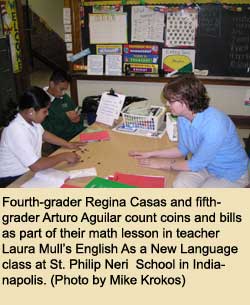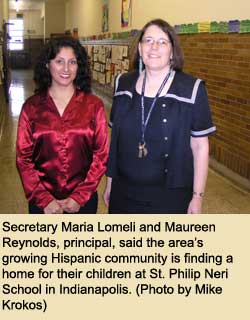Evangelization Supplement
A welcoming presence:
St. Philip Neri School is an anchor for Hispanic families
By Mike Krokos
 Maria Lomeli laughs as she talks about the various hats she wears as secretary at St. Philip Neri School in Indianapolis.
Maria Lomeli laughs as she talks about the various hats she wears as secretary at St. Philip Neri School in Indianapolis.
She served as a preschool assistant for four months before moving to the administrative job at the school two years ago. While her regular duties now include working closely with principal Maureen Reynolds and answering the phone and the myriad of questions that come from the students on a daily basis, she also serves as an anchor for the many Hispanic families who come to the pre-kindergarten through eighth-grade school for assistance.
“Most of them I know from Mexico,” Lomeli said of many of the families who have found a school home for their children at St. Philip Neri.
A native of Tala, Mexico, a city near Guadalajara, Lomeli moved to Indianapolis 13 years ago. Many of the newer Mexican families come from Tala, and they feel very much at ease when they see Lomeli’s welcoming presence at the school.
“I work a lot with the Hispanic families [who come to the school],” Lomeli said. “I help them with paperwork and other concerns they have.
“I can support them and translate for them too,” she added. “I am a multipurpose person.”
Lomeli, who is bilingual, also does her best to make sure the Hispanic students don’t fall back into old habits—like only communicating with her in Spanish.
Whenever they stop by to see her, “I’m trying to talk with them in English,” she said. Although she wants the students to be comfortable at school, Lomeli said she also knows it is important for them to become fluent in their new language.
To say the demographics around St. Philip Neri Parish and school are changing would be an understatement. What was founded as an Irish immigrant parish nearly 100 years ago—in 1909—has evolved in recent years into a neighborhood that now is home to a predominately Hispanic population.
 The school’s population shift in recent years reflects that, said Margarita Solis Deal, the coordinator of Hispanic Services for the archdiocese’s Office of Catholic Education.
The school’s population shift in recent years reflects that, said Margarita Solis Deal, the coordinator of Hispanic Services for the archdiocese’s Office of Catholic Education.
Nearly 75 percent of St. Philip Neri’s 160 students are Hispanic, she said, and that figure will increase to nearly 90 percent for the 2006-07 school year.
“There’s been a long Hispanic presence at the school,” Solis Deal said, but in the last five years it has exploded. Three to four years ago, the school population was 25 percent Hispanic. Then it went up to 50 percent the following year, and it is now up to 75 percent, Solis Deal said.
The reason?
“I think that’s what happens when a family finds out they have access to school financial aid,” she said.
“This is a low-income community, and the majority [of the students] receive financial aid.”
Reynolds, the school’s principal, noted that more than 90 percent of the student population receives free or reduced lunches.
But the financial assistance is only one of the reasons the families are drawn to St. Philip Neri.
The growing Hispanic presence at the school has helped gain the trust of many of the newer parents, Solis Deal said, adding that the demographic connection to Tali has brought many families as well.
“I think what makes it [the school] so attractive is that it is very warm and welcoming,” Reynolds added.
“It’s very family oriented, and we respect the families’ backgrounds.”
The school this year also started an English As a New Language program where teacher Laura Mull works with newly arrived students from Latin American countries, including Mexico and Honduras. In the multi-grade classroom of seven students, “[the students] have an integrated experience with their peers,” Solis Deal said.
“It’s different,” said Mull, a 2005 graduate of Indiana University-Purdue University in Indianapolis, of her first teaching job. “It’s exactly what I wanted.”
What makes the English immersion program even more unique is the fact that Mull is not bilingual.
“It’s one of the few programs in the state like this,” Solis Deal said.
“In school, the kids need to be learning English,” she added.
While the students are getting acclimated in the classroom, other Hispanic family members are growing accustomed to their new lives here as well. Some tackle whatever jobs come their way while others open businesses in their neighborhood.
“I think they feel very comfortable here,” said Father Carlton Beever, who has served as St. Philip Neri’s pastor for six years.
At the parish, Father Beever has seen the changing demographic. When he arrived, the parish, which has approximately 380 households, was 50 percent Anglo, 45 percent Hispanic and 5 percent African-American. Today, it is 80 percent Hispanic, 15 percent Anglo and 5 percent African-American. The Hispanic families come from Mexico and Honduras as well as Guatemala, Nicaragua and El Salvador.
“You can see how it’s changed so much,” he said.
One reason for that, he said, is many of the older members of the parish have died or moved away, and Hispanics are moving into their homes.
That, in turn, has put a different face on the area.
“I think economically this is a struggling neighborhood, a lower-income, middle-class one,” he said. “It is no longer an Irish-American parish.”
But the parish families that have stayed are doing their part to open their arms to the newcomers, Father Beever said.
“The average parishioners have made a real effort to be welcoming,” he said. “We’re also constantly making an effort to integrate the two communities.”
Three Hispanics now serve on the parish council, he noted.
That is all part of the parish’s evangelization efforts, said Father Beever, who through tutoring and two immersion visits to Mexico became fluent in Spanish to better serve the parish. Besides celebrating Mass, he is able to deliver homilies in Spanish. He and others also encourage the Hispanic families to bring their cultures and traditions to the parish and school.
“We celebrate quinceñeras [a girl’s 15th birthday where the community celebrates the young lady’s transition from childhood to adulthood], weddings and baptisms,” he said. “It’s helped to encourage them to be a part of the community.”
“I do think, to some degree, the school has brought a reconnection for some of the families to Church,” Reynolds added.
Father Michael O’Mara, who served as St. Philip Neri pastor from 1991 to 1996 and later again as administrator for 19 months from 2004 to 2006, said Hispanic families are making the most of what the school and parish offer them.
“They are looking for a place for their children to get the best education possible rooted in faith,” he said. “It’s still good to see a place where immigrants can find refuge and [a place for] their ideals in life.” †

